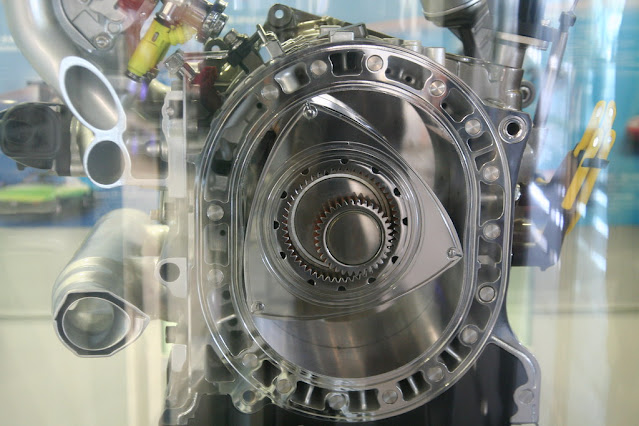The Wankel (rotary) engine has a unique performance profile compared to traditional piston engines. Below is a detailed breakdown of its key performance characteristics:
%20Engine.jpg)
1. Power Output & RPM Capability
✅ High Power-to-Weight Ratio
Fewer moving parts = lighter engine.
Example: Mazda 13B (1.3L twin-rotor) produces 232 HP naturally aspirated (~178 HP/L), while turbocharged versions (e.g., RX-7 FD3S) reached 276+ HP.
Racing variants (e.g., Le Mans 787B) exceeded 700 HP in 4-rotor configurations.
✅ Extremely High Revving
No reciprocating mass (unlike pistons) allows 10,000+ RPM in race-tuned engines.
Smoother power delivery due to continuous rotation.
❌ Low Torque at Low RPM
Weak low-end torque due to poor combustion efficiency at low speeds.
Requires high RPMs (5,000+) for peak power (similar to motorcycle engines).
2. Fuel Efficiency & Emissions
❌ Poor Fuel Economy
Long, thin combustion chamber leads to slow flame propagation and incomplete burning.
Typically 20-30% worse fuel efficiency than equivalent piston engines.
❌ High Emissions (Especially Hydrocarbons)
Unburnt fuel escapes due to poor combustion sealing.
Early Wankels struggled to meet emissions standards (leading to the RX-8’s discontinuation).
3. Reliability & Durability
✅ Fewer Moving Parts = Less Wear
No valves, camshafts, or connecting rods = lower mechanical stress.
❌ Apex Seal Failures (Biggest Weakness)
Apex seals (critical for compression) wear out quickly under high boost or poor lubrication.
Turbocharged Wankels (e.g., RX-7) often require rebuilds every 80,000–100,000 miles.
Oil injection system (to lubricate seals) increases oil consumption.

check this out : Wankel Engine (Rotary Engine) - Overview
4. Thermal Efficiency & Heat Management
❌ Low Thermal Efficiency (~20-25%)
Poor combustion chamber shape = wasted energy.
Piston engines (especially diesels) achieve 30-40%+ efficiency.
❌ Overheating Issues
Hot spots develop in the housing due to uneven heat distribution.
Cooling system must be robust (RX-7 had two oil coolers).
5. Performance Comparison: Wankel vs. Piston Engine
| Metric | Wankel Engine | Piston Engine |
|---|---|---|
| Power Density | ⭐⭐⭐⭐⭐ (Very High) | ⭐⭐⭐ (Moderate) |
| Torque (Low RPM) | ⭐ (Weak) | ⭐⭐⭐⭐ (Strong) |
| Max RPM | ⭐⭐⭐⭐⭐ (10,000+) | ⭐⭐⭐ (6,000-8,000) |
| Fuel Efficiency | ⭐ (Poor) | ⭐⭐⭐⭐ (Better) |
| Emissions | ⭐ (High HC/CO) | ⭐⭐⭐ (Cleaner) |
| Reliability | ⭐⭐ (Seal Wear) | ⭐⭐⭐⭐ (More Durable) |
check this out : Electronic Catalytic Converter: Next-Gen Emission Control
6. Racing & High-Performance Applications
Despite drawbacks, Wankels excelled in motorsports:
Mazda 787B (Le Mans 1991 Winner) – 4-rotor, 900 HP, first (and only) rotary-powered car to win Le Mans.
RX-7 (Group B, IMSA GTP) – Dominated with turbocharged 13B engines.
Drag Racing – Lightweight + high RPM = great for power-to-weight builds.
7. Modern Developments & Future Potential
🔧 Mazda’s Rotary Revival (MX-30 e-Skyactiv R-EV)
Uses a Wankel as a range extender (not primary drive), improving efficiency.
🔥 Hydrogen Wankel Research
Hydrogen burns cleaner and could solve emissions issues.
Mazda tested hydrogen-powered RX-8 prototypes.
🚁 Drone & UAV Applications
Lightweight + high-RPM advantage makes it ideal for aviation.
check this out : 20 questions answered about Ignition System type
Conclusion: Who Should Use a Wankel Engine?
✔ Best For:
Racing (high-RPM power, lightweight).
Enthusiasts (unique sound, smooth power).
Hybrid/range-extender applications (Mazda’s new approach).
❌ Worst For:
Daily drivers (fuel costs, reliability concerns).
Off-road/towing (low torque).
The Wankel remains a niche but fascinating engine, beloved for its high-revving character and compact design, but held back by efficiency and durability issues.

Post a Comment